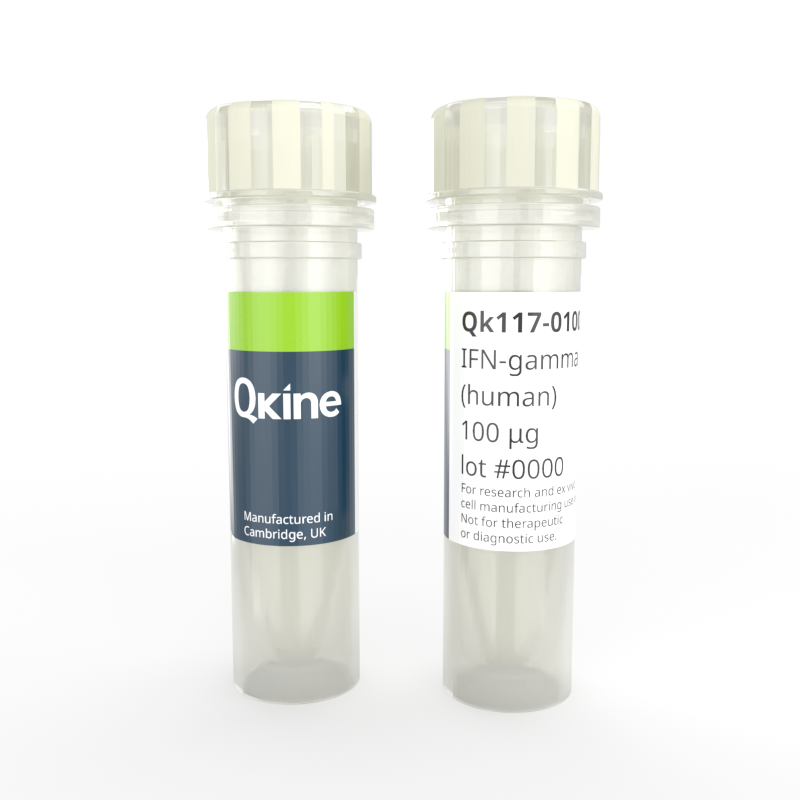Recombinant human IFN-gamma protein
QK117
Brand: Qkine
IFN-gamma (interferon-gamma) is a cytokine crucial for immune responses, produced by T cells and natural killer cells. It activates macrophages, enhances antigen presentation, and plays a key role in inflammation.
Qkine has optimised the IFN-gamma manufacture process to produce a highly bioactive protein with excellent lot-to-lot consistency for enhanced experimental reproducibility. Qkine IFN-gamma is a highly pure 16.8 kDa protein, animal origin-free (AOF) and carrier-protein-free (CF).

Currency:
| Product name | Catalog number | Pack size | Price | Price (USD) | Price (GBP) | Price (EUR) |
|---|---|---|---|---|---|---|
| Recombinant human IFN-gamma protein, 50 µg | QK117-0050 | 50 µg | (select above) | $ 185.00 | £ 140.00 | € 164.00 |
| Recombinant human IFN-gamma protein, 100 µg | QK117-0100 | 100 µg | (select above) | $ 280.00 | £ 210.00 | € 246.00 |
| Recombinant human IFN-gamma protein, 500 µg | QK117-0500 | 500 µg | (select above) | $ 725.00 | £ 540.00 | € 631.00 |
| Recombinant human IFN-gamma protein, 1000 µg | QK117-1000 | 1000 µg | (select above) | $ 1,050.00 | £ 800.00 | € 935.00 |
Note: prices shown do not include shipping and handling charges.
Qkine company name and logo are the property of Qkine Ltd. UK.
Alternative protein names
Species reactivity
human
species similarity:
mouse – 40%
rat – 38%
porcine – 59%
bovine – 61%
Summary
- High purity human IFN-gamma protein (UniProt number: P01579)
- 16.9 kDa (monomer)
- >98%, by SDS-PAGE quantitative densitometry
- Expressed in E. coli
- Animal origin-free (AOF) and carrier protein-free
- Manufactured in Qkine's Cambridge, UK laboratories
- Lyophilized from HEPES, mannitol
- Resuspend in sterile-filtered water at >50 µg/ml, add carrier protein if desired, prepare single use aliquots and store frozen at -20 °C (short-term) or -80 °C (long-term).
Featured applications
- Antigen presentation enhancement
- Autoimmune disease research
- Cancer immunotherapy
- Hematopoietic stem cell regulation
- Immunoregulatory function
- Involvement in infectious diseases
Bioactivity
Recombinant IFN-gamma activity was determined using a cytotoxicity assay. HT-29 cells were treated in triplicate with a serial dilution of IFN-gamma for 88.5 hours. Cell viability was measured using the CellTiter 96 AQueous Cell Proliferation Assay (Promega). Assay was performed by SBH Sciences. Data from Qk117 lot 204692. EC50 = 0.62 ng/mL (37 pM).

Purity
Recombinant IFN-gamma monomer migrates at approximately 17 kDa (monomer) in reduced (R) and non-reduced (NR) conditions. The dimeric form is also observed at approximately 34 kDa. No contaminating protein bands are present. The purified recombinant protein (3 µg) was resolved using 15% w/v SDS-PAGE in reduced (+β-mercaptoethanol, R) and non-reduced (NR) conditions and stained with Coomassie Brilliant Blue R250. Data from Qk117 lot #204692.

Further quality assays
- Mass spectrometry: single species with expected mass
- Endotoxin: <0.005 EU/μg protein (below level of detection)
- Recovery from stock vial >95%

Qkine IFN-gamma is as biologically active as a comparable alternative standard protein. Recombinant IFN-gamma activity was determined by a cytotoxicity assay using HT-29 cells. Cells were treated in duplicate with a serial dilution of Qkine IFN-gamma (Qk117, green) for 88.5 hours. Cell viability was measured using the CellTiter 96 AQueous Cell Proliferation Assay (Promega). Assay was performed by SBH Sciences using their standard (black) for comparison. Data from Qk117 lot #204692.
Protein background
IFN-gamma (interferon-gamma / IFN-γ) is a cytokine and a critical player in the immune response. It is primarily produced by T cells (particularly CD4+ and CD8+ T cells) and natural killer (NK) cells, and it plays a pivotal role in immune modulation, particularly in activating macrophages, enhancing antigen presentation (e.g., MHC I and II), and driving the Th1 immune response. IFN-gamma also has antiviral, antiproliferative, and immunoregulatory functions [1].
IFN-gamma is a non-covalent dimer with α-helical regions contributing to its overall structure, it binds to the interferon-gamma receptor (IFNGR), a transmembrane receptor composed of two subunits: IFNGR1 and IFNGR2. Upon binding to this receptor, IFN-gamma triggers the JAK-STAT signaling pathway, leading to the transcription of interferon-stimulated genes (ISGs) involved in immune regulation [1].
IFN-gamma is widely used for its immunomodulatory effects. One key application is cancer immunotherapy, which enhances the immune system’s ability to detect and eliminate tumor cells. It is also crucial in studying autoimmune diseases, as excessive production is linked to conditions like multiple sclerosis and rheumatoid arthritis [2].
IFN-gamma is commonly used in cell culture to mimic an inflammatory environment. For example, it can be applied to macrophages or other immune cells to activate them and study their response to pathogens or cancer cells. Its role in promoting antigen presentation is also exploited in vaccine development, where it boosts the efficacy of immune responses against pathogens [3].
Background references
- Green, Angela M., et al. “IFN-γ from CD4 T Cells Is Essential for Host Survival and Enhances CD8 T Cell Function during Mycobacterium Tuberculosis Infection.” Journal of Immunology (Baltimore, Md.: 1950), vol. 190, no. 1, Jan. 2013, pp. 270–77. https://doi.org/10.4049/jimmunol.1200061.
- Savan, Ram, et al. “Structural Conservation of Interferon Gamma among Vertebrates.” Cytokine & Growth Factor Reviews, vol. 20, no. 2, Apr. 2009, pp. 115–24. https://doi.org/10.1016/j.cytogfr.2009.02.006.
- Young, H. A., and J. H. Bream. “IFN-Gamma: Recent Advances in Understanding Regulation of Expression, Biological Functions, and Clinical Applications.” Current Topics in Microbiology and Immunology, vol. 316, 2007, pp. 97–117. https://doi.org/10.1007/978-3-540-71329-6_6.